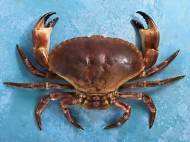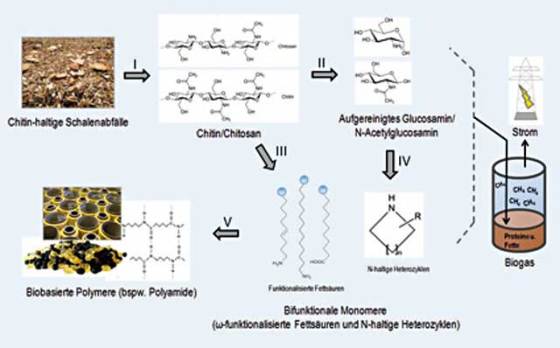ChiBio Project focused on development of a biorefinery for crustacean shells
 Aside efforts to utilize crustacean shells by extracting chitin and turning it into pharmaceuticals with fungi, researchers in Asia successfully managed to extract polymer chitosan from shrimp shells in order to make filters, foils and wound dressings. 750,000 tones of crustacean shells are annually disposed in EU, however, crustaceans in Europe contain more lime and calcium carbonate which prevented cost effective conversions to chitosan.
Aside efforts to utilize crustacean shells by extracting chitin and turning it into pharmaceuticals with fungi, researchers in Asia successfully managed to extract polymer chitosan from shrimp shells in order to make filters, foils and wound dressings. 750,000 tones of crustacean shells are annually disposed in EU, however, crustaceans in Europe contain more lime and calcium carbonate which prevented cost effective conversions to chitosan.
A solution has come from the ChiBio Project, where an international group of researchers develops an integrated biorefinery which refines chitin rich biowaste. Chitin is a biopolymer occurring in insects and fungi that consists of nitrogenous sugar molecules strung together in a polymer chain. The project aims to transform the chemical constituents of EU, African and Asian crustacean shell waste into chemical intermediates to produce high performance bio-based polymers at high atom efficiencies.
“In the manner of a biorefinery we want to develop or optimize various material and energetic uses for the waste material of crustacean shells, and thus utilize the residual material as efficiently and completely as possible”, said Professor Volker Sieber, coordinator of ChiBio and head of the BioCat Project Group of the Fraunhofer Institute for Interfacial Engineering and Biotechnology (Fraunhofer IGB).
Instead producing chitosan, the ChiBio Project researchers focused on production of polyamides and other polymers that could be used as biobased plastics. They aim to combine chemical steps with biotechnological processes in order to create biogas. The idea is to ferment all the bio-based byproducts generated in the process chain together with the initially separated proteins and fats and produce biogas as a regenerative energy carrier.
The project intends to evaluate the environmental impact of the process chain with a cradle-to-product life cycle analysis, as well as modeling and optimization studies to demonstrate the economic viability. The researchers also plan to analyze whether the process developed for European waste could also be applied for the shell waste from Asia. If it proves successful, the method will be a great addition to ways to recycle crustacean shell waste, which is usually disposed in landfills.










Leave your response!